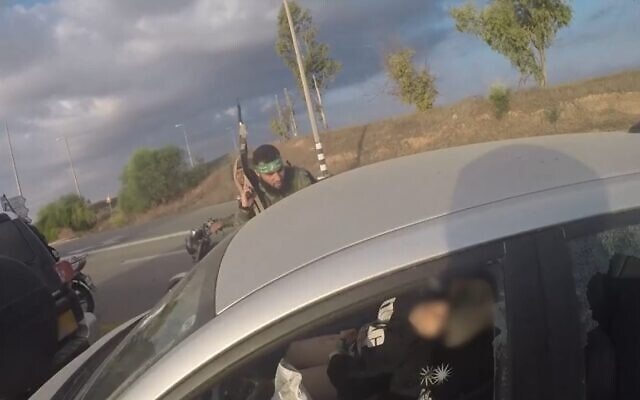Gil Zohar Religion Unplugged
(The Other Cheek has removed the videos supplied in the original version of this story.)
TEL AVIV — Dead silence interrupted by anguished howls.
That was the reaction among the 200 foreign journalists present at an IDF briefing at a military base in the centre of the country who were shown a harrowing 43-minute compilation of Hamas bodycam videos and other raw footage documenting the Oct. 7 massacre of civilians in southern Israel.
Overwhelmed with grief, some journalists stepped out of the auditorium early.
The grisly documentation featuring decapitations and torture was released on Monday to dispel what Israeli government spokesman Eylon Levy characterized as “a Holocaust-denial-like phenomenon happening in real-time” as some on social media question the veracity of the jihadi terrorists’ atrocities.
More than 1,400 civilians hailing from Israel, the United States, Canada, Great Britain, France, Germany, Spain, Ukraine, Thailand, Nepal, the Philippines and Argentina were massacred. Many of them were shot in cold blood at a music festival or murdered inside their home.
Unedited and extremely graphic, the footage was collected from terrorists’ body cameras, kibbutz security footage and car dashboard cameras, Hamas and victims’ social media accounts and cellphones used by terrorists, victims and first responders to record what was going on.
The Israeli Defense Forces grappled with whether to release the horrific videos, given sensitivity to the dead and their families. In the end, officials determined that since some of the material was already circulating on social media, the footage should be screened to the media to counter Hamas’s propaganda downplaying or denying the atrocities.
At the briefing, journalists were required to surrender their cellphones and other recording equipment before entering the hall at the IDF base. A heavily censored clip was subsequently released.
In one segment, captured through a recording app on a murdered woman’s cell phone, a jubilant terrorist brags to his father in Gaza City: “Dad, I killed 10 with my bare hands. Their blood is on my hands. Please be proud of me.”
Identified by his father as Mahmoud, he urges his family to look at his WhatsApp messages for further evidence.
In another video, Hamas gunmen disguised in IDF uniforms flag down a passing car and execute two occupants. The blood-soaked corpses are dragged out of the vehicle and dumped in the middle of the road. Some of the bullet-ridden cars along the roadway are stolen.
Another video shows first responders pouring water over still-smouldering charred bodies to quench the smoking embers. In yet another, a bleeding man — seemingly an agricultural labourer from Southeast Asia — writhes in pain on the ground while a terrorist repeatedly tries to sever his head with a farming tool.
Another clip captures an Israeli woman attempting to determine if a partially burned and mutilated corpse is that of a family member. The victim’s dress is in disarray, and her underpants removed.
Maj.-Gen. Mickey Edelstein, who briefed reporters after the screening, said that “we have evidence” of rape, but “we cannot share it.” He declined to elaborate.
Home security footage recorded in a kibbutz near the Gaza-Israel border shows a father racing with his two sons — ages seven and nine — to a nearby bomb shelter. The three are dressed only in their underwear. Moments later, a terrorist lobs a grenade into the shelter. The father falls dead. His traumatized sons exit smattered with his blood.
“Dad’s dead, it wasn’t a prank,” one says, according to the recording, after they run back into their home.
“I know, I saw it,” responds his brother, later screaming, “Why am I alive?”
The IDF also selected footage from the Gaza Strip that was uploaded to social media soon after the attacks. One video showed a blood-soaked IDF soldier being pulled from a car, kicked and beaten by a Palestinian crowd. From the video, it is unclear whether he is still alive.
Another clip showed a terrorist repeatedly firing at a pet dog.
“When we say Hamas is ISIS,” Rear Admiral Daniel Hagari said after the screening, “it’s not a branding effort.”
Gil Zohar was born in Toronto and moved to Jerusalem in 1982. He is a journalist writing for The Jerusalem Post, Segula magazine and other publications. He’s also a professional tour guide who likes to weave together the Holy Land’s multiple narratives. Used with Permission.

